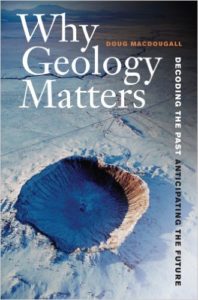
WHY GEOLOGY MATTERS
Decoding the Past, Anticipating the Future
Doug Macdougall
University of California Press (2012)
Paper • ISBN 9780520272712 • US $29.95 • 304 pgs.
ABOUT THE BOOK:
Volcanic dust, climate change, tsunamis, earthquakes—geoscience explores phenomena that profoundly affect our lives. But more than that, as Doug Macdougall makes clear, the science also provides important clues to the future of the planet. In an entertaining and accessibly written narrative, Macdougall gives an overview of Earth’s astonishing history based on information extracted from rocks, ice cores, and other natural archives. He explores such questions as: What is the risk of an asteroid striking Earth? Why does the temperature of the ocean millions of years ago matter today? How are efforts to predict earthquakes progressing? Macdougall also explains the legacy of greenhouse gases from Earth’s past and shows how that legacy shapes our understanding of today’s human-caused climate change. We find that geoscience in fact illuminates many of today’s most pressing issues—the availability of energy, access to fresh water, sustainable agriculture, maintaining biodiversity—and we discover how, by applying new technologies and ideas, we can use it to prepare for the future.
PRAISE:
“What you will find in this clearly written and instructive book is a summary of what geologists do (it isn’t just dig for oil or other valuables), how they have come to understand the immense range of times involved in Earth’s creation and transformation into our livable world, and most importantly how geology, thought of as the dusty study of ancient ages, is key to understanding the most important of the resource and environmental issues that will confront us in the future. It is a wonderful primer on geology, and a clear explanation of how the science is done.”
Rob Hardy, Columbus Dispatch
“MacDougall has given us a gem, a book that removes emotion and apocalyptic hyperbole from the equation and provides a sober analysis of why most scientists have come to the conclusion they have about how human activity has started to play a role in the Earth’s climate.”
Jim Trageser, North County Times
“[Macdougall] addresses ways to apply geology to questions . . . and presents all in an enjoyable reading stye.”
Choice
“In an entertaining and accessibly written narrative, Macdougall gives an overview of Earth’s astonishing history based on information extracted from rocks, ice cores, and other natural archives.”
Scienceblogs.com/The Guardian
“Macdougall does a masterful job of exploring the questions, dilemmas, and insights that have led to today’s scientific understanding of the composition of our planet. His approach is not ‘rocks on a shelf’ science; it’s a compelling, interdisciplinary peek at Earth’s prehistory—including those processes that support so much of modern civilization.”
Ernest Zebrowski, author of Global Climate Change and Category 5: The Story of Camille
“The story of Earth is told in such geologic forms as rock strata, volcanic eruptions, meteor craters, fossils, ocean currents, and ice flows. Macdougall gives these disparate elements voice and puts them into a perspective that emphasizes why Earth science is important in our understanding of both the planet’s history and our role in its tomorrow.”
Jeff Kanipe, author of The Cosmic Connection: How Astronomical Events Impact Life on Earth
OTHER BOOKS BY THIS AUTHOR:
Frozen Earth: The Once and Future Story of Ice Ages
Nature’s Clocks: How Scientists Measure the Age of Almost Everything
ABOUT THE AUTHOR:
Doug Macdougall is a writer and geoscientist and a professor emeritus of Earth Schiences at the Scripps Institution of Oceanography, University of California, San Diego. He is a fellow of the American Geophysical Union and the Meteoritical Society, and he has written four previous non-fiction trade books as well as one novel. See his website here: www.dougmacdougall.com
RIGHTS INFORMATION:
For all languages and territories, please contact Taryn Fagerness at Taryn Fagerness Agency.
See here for a list of Taryn Fagerness’s foreign subagents.
